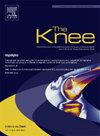平衡单间室膝关节置换术后,外侧间室增加的力量和接触面积可能易导致关节炎进展:尸体比较
IF 2
4区 医学
Q3 ORTHOPEDICS
引用次数: 0
摘要
与全膝关节置换术相比,单室膝关节置换术(UKA)具有更快恢复和改善功能等优点。本研究评估了传统和机器人辅助UKA技术在接触压力、力和面积方面的生物力学差异。方法对16例新鲜冷冻尸体下肢标本进行UKA,其中8例采用标准切割夹具(常规UKA), 8例采用CORI机器人辅助技术。在膝关节从90°屈曲到0°的控制过程中,FlexiForce (Tekscan)传感器测量了内侧(替代)和外侧(原生)隔室的接触压力、力和面积。对生物力学参数进行统计学比较。结果内侧接触压力从90°时的251.73 KPa显著增加到0°时的1863.83 KPa (p <;0.05),侧压较低,为319.83 ~ 733.94 KPa (p <;0.05)。与内侧隔室的43.91 mm2到44.65 mm2相比,外侧隔室的接触面积一直较高,从90°时的81.46 mm2增加到0°时的134.38 mm2。0.05)。在各个角度上,侧室的力值也更高,在97.84 N处达到峰值,而在0°(p <;0.05)。在传统和机器人辅助技术之间没有观察到显著差异(p >;0.05)。结论两种UKA技术表现出相似的生物力学结果。实现软组织平衡仍然是减少内侧室压力和优化负荷分配的关键。与内侧腔室相比,外侧腔室表现出更高的力和接触面积,由于负载不平衡,潜在地加速了UKA后外侧关节炎的发展。本文章由计算机程序翻译,如有差异,请以英文原文为准。
Increased force and contact area in the lateral compartment may predispose to arthritis progression after balanced unicompartmental knee arthroplasty: A cadaveric comparison
Introduction
Unicompartmental knee arthroplasty (UKA) offers advantages such as faster recovery and improved function compared to total knee arthroplasty. This study evaluates the biomechanical differences in contact pressure, force, and area between conventional and robotic-assisted UKA techniques.
Methods
Sixteen fresh-frozen cadaveric lower limb specimens underwent UKA, with eight using standardized cutting jigs (conventional UKA) and eight using CORI robotic-assisted technology. FlexiForce (Tekscan) sensors measured contact pressure, force, and area in the medial (replaced) and lateral (native) compartments during controlled knee extension from 90° flexion to 0°. Biomechanical parameters were statistically compared.
Results
Medial contact pressure increased significantly from 251.73 KPa at 90° to 1863.83 KPa at 0° (p < 0.05), while lateral pressures remained lower, ranging from 319.83 KPa to 733.94 KPa (p < 0.05). The lateral compartment exhibited consistently higher contact areas, increasing from 81.46 mm2 at 90° to 134.38 mm2 at 0°, compared to the medial compartment’s 43.91 mm2 to 44.65 mm2 (p < 0.05). Force values were also higher in the lateral compartment across all angles, peaking at 97.84 N compared to 83.01 N medially at 0° (p < 0.05). No significant differences were observed between conventional and robotic-assisted techniques (p > 0.05).
Conclusion
Both UKA techniques demonstrated comparable biomechanical outcomes. Achieving soft tissue balance remains critical for reducing medial compartment pressure and optimizing load distribution. The lateral compartment exhibits higher forces and contact areas compared to the medial compartment, potentially accelerating the development of arthritis in the lateral side after UKA due to load imbalance.
求助全文
通过发布文献求助,成功后即可免费获取论文全文。
去求助
来源期刊

Knee
医学-外科
CiteScore
3.80
自引率
5.30%
发文量
171
审稿时长
6 months
期刊介绍:
The Knee is an international journal publishing studies on the clinical treatment and fundamental biomechanical characteristics of this joint. The aim of the journal is to provide a vehicle relevant to surgeons, biomedical engineers, imaging specialists, materials scientists, rehabilitation personnel and all those with an interest in the knee.
The topics covered include, but are not limited to:
• Anatomy, physiology, morphology and biochemistry;
• Biomechanical studies;
• Advances in the development of prosthetic, orthotic and augmentation devices;
• Imaging and diagnostic techniques;
• Pathology;
• Trauma;
• Surgery;
• Rehabilitation.
 求助内容:
求助内容: 应助结果提醒方式:
应助结果提醒方式:


